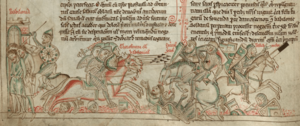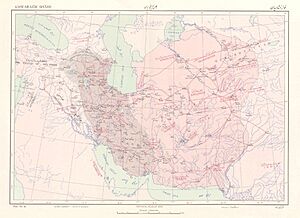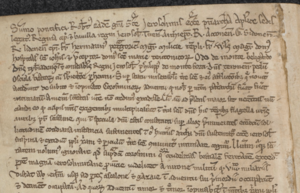Khwarazmian army between 1231 and 1246 facts for kids
The Khwarazmian army, also known as the Khwarazmiyya, was a group of soldiers who became freebooters and mercenaries between 1231 and 1246. This happened after the Mongol Empire conquered their homeland, the Khwarazmian Empire, in 1221. Their last leader, Jalal al-Din, died in 1231.
These soldiers were active in places like Upper Mesopotamia, Anatolia, Syria, and Palestine. They often changed who they fought for and sometimes acted on their own. Eventually, they were defeated and destroyed by the Ayyubids, a powerful Muslim dynasty.
In 1231, the Khwarazmians briefly worked for Ayyubid governors near Lake Van. From 1231 to 1237, they served the Seljukid sultanate of Rum. They even helped fight off an Ayyubid invasion in 1232–1233.
By 1237, the Khwarazmians were pushed back into Upper Mesopotamia. This happened during a time when the Seljukid rulers were having problems deciding who would be the next sultan. After this, the emir of Damascus, an Ayyubid ruler, hired them. They joined in the Ayyubid civil wars in Syria, attacking the emir of Aleppo in 1240 and 1241.
After their second attack failed, they went back to central Mesopotamia. There, they worked for the Abbasid caliphate, another powerful Muslim ruler. Later in 1241, the Khwarazmians were hired by the Zengid emir of Mosul. Soon after, they returned to the Ayyubid conflicts in Syria. They were defeated by Aleppo again in 1242.
In 1243, the Khwarazmians made an alliance with the Ayyubid sultan of Egypt. A year later, in 1244, they invaded Palestine. They sacked Jerusalem and then defeated an alliance against Egypt at the Battle of Forbie. This battle permanently ended Crusader rule in Jerusalem. In 1245, they helped the Egyptians conquer Damascus.
However, they were not happy with their rewards. So, in 1246, they rebelled and tried to besiege Damascus. But they suffered a huge defeat from an alliance led by Aleppo. After this, they broke apart as a strong, unified army.
Contents
How the Khwarazmian Army Started
The Khwarazmian army was largely destroyed by the Mongols at the battle of the Indus in 1221. Their leader, Jalal al-Din, gathered the remaining soldiers. He then created a new empire in Punjab and Sind (parts of modern-day Pakistan and India). He stayed there for about three years.
In late 1223, Jalal al-Din left governors and troops behind. He then set out to rebuild the Khwarazmian Empire in its original lands and further west. A historian named al-Nasawi said he returned to Kerman with 4,000 soldiers. In Iran, he added more soldiers who had been loyal to his father.
Jalal al-Din spent the next few years fighting his Christian and Muslim neighbors. He did not focus on fighting the Mongols. In 1230 or 1231, he was defeated by an alliance of Seljukid and Ayyubid forces at the battle of Yasi-chimen. Before he could gather more troops, the Mongols attacked again.
Jalal al-Din fled with his remaining army. He first went to the Mughan Steppe and then towards Diyar Bakr. He was defeated by the Mongols near Amida and lost many soldiers. In 1231, a Kurd murdered him while he was seeking safety with Shahib al-Din Ghazi, the emir of Mayyafariqin.
Who Were the Khwarazmian Soldiers?
After Jalal al-Din died, about 12,000 to 15,000 of his soldiers in Diyar Bakr became mercenaries. This means they offered their fighting skills for hire. Some historians say the number was around 10,000 when they first joined the Seljukid army.
These soldiers were called Khwarazmiyya in Arabic writings. They were among the first wafidiyya, which were groups of refugee soldiers from the east. These groups often found work in Syria and Egypt. In Latin writings, they were called chorosmini or similar names.
Their collective name, Khwarazmiyya, came from their service to the last Khwarazmshah. It didn't mean they all came from the same tribe. Most of them were Kipchak Turkish cavalrymen. They were nomadic horsemen who had no home to return to because the Mongols had destroyed their lands. Besides Kipchaks, there were likely also Kangly, Khalaj, and Oghuz Turks. The Oghuz Turks were the same people as the Seljukids.
These Khwarazmian soldiers traveled with their families. They also had staff like katibs (secretaries) and faqihs (jurists). The jurists were mostly from Iran.
The leaders of the army chose Husam al-Din Kirkhan Malik as their main leader. Other important leaders included Husam al-Din Berke-Khan, Yilan-Bughu, and Saru-Khan.
Working for the Seljukids
Under Kirkhan, the Khwarazmians first worked for the Ayyubid rulers Ghazi of Mayyafariqin and al-Ashraf of Akhlat. In 1231 or 1232, they changed sides. They joined their former enemy, the Seljukid sultan Kayqubad I. This happened through a frontier commander named Sinan al-Din Kaymaz.
In a ceremony in Tatvan, Kaymaz received promises of loyalty from Kirkhan and the other Khwarazmian leaders. He gave them official papers for different iqta's. An iqta' was a district where they could collect tax revenue. These lands were in the frontier province of Erzurum and included about 36 castles. About 300 Khwarazmian leaders also received special robes of honor.
Soon after, about 4,000 Khwarazmians tried to return to Khwarazm. But they were surprised by 700 Mongol raiders near the village of Tugtap. They fled into Seljukid lands and asked for safer areas. Kaymaz sent them to Kayseri. There, the sultan himself gave them new iqta's. Kirkhan received Erzinjan, and other leaders received places like Amasya and Nigde.
In 1232, the Ayyubid sultan al-Kamil invaded Seljukid Syria. The Khwarazmians under Kirkhan fought with Kayqubad. They successfully defended the Taurus passes near Hadath. When the Artukids of Khartpert rebelled to support al-Kamil, the Ayyubid tried to send them help. Kayqubad and the Khwarazmians trapped the enemy forces in the city, forcing them to surrender.
In 1233, al-Kamil retreated to Egypt. In 1234, Kayqubad besieged Amida. His Khwarazmian soldiers raided areas around Nisibis and Sinjar. They even reportedly raided Mardin, even though the Artukids of Mardin were allied with the Seljukids. They did this to get revenge for Jalal al-Din.
When Kayqubad died in 1237, there was a disagreement over who would be the next sultan. His oldest son, Ghiyath al-Din Kaykhusrau, and his chosen successor, 'Izz al-Din, both wanted the throne. The Khwarazmians were unsure whom to support. So, Kaykhusrau's chief minister, Sa'd al-Din Köpek, had their leaders arrested.
The Khwarazmians were forced to leave the Seljukids. They retreated across the Euphrates River into the Jazira region. With permission from al-Kamil, the Ayyubid emir al-Salih Ayyub hired them for his army. He gave them iqta's in Diyar Mudar. Köpek accused some leaders of encouraging the Khwarazmians to leave Kaykhusrau and join the Ayyubids. The atabeg Altunbeh was executed because of this. After Köpek was assassinated in 1240, Kaykhusrau tried to call the Khwarazmians back, but they refused.
Attacks on Syria, Palestine, and Transjordan
First Attack in 1240
In 1239, al-Salih Ayyub was captured and put in prison in Kerak by al-Nasir Da'ud. Al-Nasir Da'ud claimed he was just protecting al-Salih Ayyub and would release him. To do this, he asked the Khwarazmians to attack Homs and Aleppo.
A messenger named Jamal al-Din ibn Matruh gave al-Nasir Da'ud's letter to Berke-Khan in Harran. The Khwarazmians didn't act right away. But in the autumn of 1240, they crossed the Euphrates and raided northern Syria. No old writings explain why they invaded.
The Khwarazmian army had about 12,000 soldiers. On November 2, 1240, they defeated 1,500 cavalry led by al-Mu'azzam Turanshah from Aleppo. On November 9, they burned Manbij. When the Emir al-Mansur Ibrahim of Homs heard about Aleppo's defeat, he brought his forces to Aleppo. He had 1,000 cavalry from Homs and Damascus. He planned to use them against the Barons' Crusade. Before the end of the year, the Khwarazmians went back across the Euphrates.
Second Attack in 1241
After the Khwarazmians left, Dayfa Khatun sent Kamal al-Din ibn al-'Adim to Damascus to get more soldiers. al-Salih Isma'il provided them. The Seljukids also sent troops. According to Ibn Bibi, Ghiyath al-Din Kaykhusrau ordered the governor of Malatya to gather 3,000 men from border forts and send them to Aleppo. Al-Mansur Ibrahim was made the commander of these allied forces.
In January 1241, the Khwarazmians returned. They looted Sarmin, Kafartab, and Shayzar. As they were going back towards the Euphrates, al-Mansur Ibrahim caught them at Raqqa on February 19. The fighting lasted all day, but the Khwarazmians managed to cross the river. They retreated to Harran. Al-Mansur crossed the river at al-Bira. He then forced them into a big battle outside Edessa on April 5. The Khwarazmians were defeated. They went back to Harran, gathered their families, and then went to 'Ana, which belonged to the Abbasid caliph. After this victory, the people of Aleppo took control of Diyar Mudar.
Between Attacks
In 'Ana, the Khwarazmians started working for the Abbasids. Later in 1241, they joined Badr al-Din Lu'lu' of Mosul and then al-Muzaffar Ghazi of Mayyafariqin. They didn't show much loyalty to any of these rulers and kept raiding Syria. Aleppo sent a group of soldiers to punish the Khwarazmians at Safar in July–August 1241. In August 1242, a second group, led by al-Mansur Ibrahim, defeated them at Safar.
In 1243, according to Ibn Wasil, al-Salih Ayyub, who was now the ruler of Egypt, wrote to the Khwarazmians. He urged them to invade Syria. In return, he promised them large iqta's in Egypt. This caused the recent peace between the Egyptian and Syrian Ayyubids to end. In late winter or early spring of 1244, the Syrian Ayyubids allied with the Christian kingdom of Jerusalem against the Egyptian–Khwarazmian alliance. The city of Jerusalem, which had been in Muslim hands since 1239, was given back to the Christians.
Third Attack in 1244
In 1244, a historian named Muhammad ibn Ibrahim al-Khazraji wrote that al-Salih Ayyub gave the Khwarazmians the entire province of Damascus (except Nablus) as an iqta'. At the same time, a Kurdish tribe called the Qaymariyya also joined his army. These two groups formed the main part of al-Salih Ayyub's army for the upcoming wars in Syria and Palestine.
The Khwarazmians crossed the Euphrates early in the summer of 1244. Their movement might have been because a Mongol leader named Yasa'ur was pushing into northern Syria. They had 10,000 soldiers, including the Kurdish group. They split into two groups and moved into Palestine through the Biqa' and the Ghuta. When they arrived, the allied forces that had been fighting Egypt retreated. Al-Salih Isma'il left Gaza, and al-Nasir Da'ud went back to Kerak. The Franks (Crusaders) were left to face them alone.
Because of these movements, the Khwarazmians faced little resistance in Palestine. They mostly avoided large cities. However, on July 11, 1244, they appeared before Jerusalem. The city was looted. The soldiers defending the city were besieged in the Tower of David until August 23. They surrendered with a promise of safe passage. But the Christian residents were killed, and all Christian holy places in the city were destroyed. This was the end of Crusader rule in Jerusalem. Al-Salih Ayyub took control of the city in August. According to Ibn al-Furat, the Khwarazmians were given the area around Jerusalem as an iqta'.
From Jerusalem, the Khwarazmians marched to Gaza. They told al-Salih Ayyub they had arrived. He told them not to enter Egypt, so they waited for the sultan's army. The combined army, led by Rukn al-Din Baybars al-Salihi, completely defeated the Syrian-Frankish forces at the battle of Forbie on October 17. This was the worst Crusader defeat since the battle of Hattin in 1187. The Khwarazmians were the strongest part of the winning army. They swept through much of the coastal area of the kingdom of Jerusalem. However, they did not attack the strong castles, so they didn't take permanent control of those places.
After Forbie, the Khwarazmians joined the army of the Egyptian vizier Mu'in al-Din ibn al-Shaykh at Gaza. They marched to Baysan before besieging Damascus in 1245. While the Egyptian army attacked the city with large stone-throwing machines called mangonels, the Khwarazmians raided the countryside. They did this to stop food from reaching the defenders. In September 1245, al-Mansur Ibrahim thought about surrendering the city to the Khwarazmians. He secretly left Damascus to meet with the Khwarazmian leader, Berke-Khan. But nothing came of it.
Rebellion and Final Defeat
After Damascus fell in October 1245, Mu'in al-Din gave the Khwarazmians iqta's in Syria (around al-Sahil) and Palestine. But the mercenaries felt these rewards were not what the sultan had promised. Still camped near Damascus, the Khwarazmians raided the village of Darayya. To prepare for a full rebellion, they allied with al-Salih Isma'il, al-Nasir Da'ud, and 'Izz al-Din Aybeg al-Mu'azzami. They even wrote to their former commander, Rukn al-Din, who was leading the troops still at Gaza. Rukn al-Din was immediately accused of working with the Khwarazmians, called back to Egypt, and imprisoned.
In late March 1246, the Khwarazmians laid siege to Damascus. According to a historian named Ibn al-Dawadari, the disloyalty of the Khwarazmians and Qaymariyya led al-Salih Ayyub to buy "more Turkish mamlūks [slave soldiers] than all the previous sultans combined." These new soldiers became the majority of his army.
When the Khwarazmians learned that al-Mansur Ibrahim and al-Nasir Yusuf of Aleppo had allied against them, they stopped besieging Damascus. They marched north. On May 18, 1246, the two alliances met in battle near al-Qasab, by Lake Homs. The Khwarazmians and their allies were completely defeated. Berke-Khan was killed, and his head was given to Shams al-Din Lu'lu' al-Amini, who hung it from the gate of the citadel of Aleppo.
This defeat scattered the Khwarazmians. A small group stayed with al-Salih Isma'il and found safety with al-Nasir Yusuf in Aleppo. Another group fled to the Balqa' and were hired by al-Nasir Da'ud. The sultan quickly sent an army under Fakhr al-Din ibn al-Shaykh against al-Nasir Da'ud. On September 1, 1246, al-Nasir Da'ud and his Khwarazmians were defeated at al-Salt. The survivors went back to Kerak, where they were besieged. The siege ended after al-Nasir agreed to hand over the Khwarazmians to Fakhr al-Din, who added them to his own army. They eventually ended up in Egypt. Another group of Khwarazmians, led by Kushlu-Khan, joined the Mongols in Mesopotamia.
Although 1246 is when the Khwarazmians mostly disappear from Arabic writings, they show up again in the work of the historian Rashid-al-Din over ten years later. He wrote that some former leaders of Jalal al-Din came to Egypt during the rule of the Mamluk sultan Qutuz (1259–1260). Qutuz gave them gifts and asked them for information. When the Mongols demanded tribute from Egypt in 1260, the Khwarazmian leader Nasir al-Din Muhammad Kaymuri advised Qutuz that the Mongols would not keep their word. Qutuz chose to fight. There were also Khwarazmians in the Mongol army during the battle of 'Ayn Jalut in 1260. This is their last mention in history.
|





